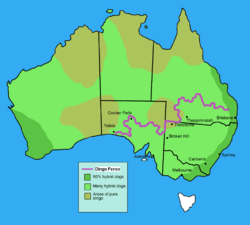Dingo Fence facts for kids
Quick facts for kids Dingo Fence |
|
|---|---|
| Australia | |

Dingo Fence on the 29th parallel south-Sturt National Park (right of fence) - looking east from Cameron Corner after rain
|
|
A portion of the dingo fence near Coober Pedy
|
|

Route of the Dingo Fence (purple)
|
|
| Type | Fence |
| Length | 5,614 km |
| Site history | |
| Built | 1880-85 |
| Materials | Wire mesh |

The Dingo Fence or Dog Fence is a very long fence in Australia. It was built to keep dingoes (wild dogs) away from sheep farms. The fence helps protect sheep in the southern and eastern parts of Australia. It is one of the longest structures ever built by humans.
The fence stretches for 5,614 kilometres (about 3,488 miles). It goes from Jimbour in Queensland through dry lands. It ends near the Nullarbor Plain in South Australia. While it has helped protect sheep, some dingoes can still be found in the south. Also, other animals like rabbits and kangaroos have increased inside the fence. They eat the grass that sheep need.
Contents
What is the Dingo Fence?
The Dingo Fence is a huge barrier designed to control dingo populations. It protects valuable sheep farms from attacks. The fence is not just one continuous structure. It is made up of several connected sections.
How Long is the Fence?
The fence is incredibly long, stretching across several Australian states.
- The Queensland section is about 2,500 kilometres (1,553 miles) long. It is also called the Great Barrier Fence.
- The Queensland Border Fence runs for 394 kilometres (245 miles) along the border with New South Wales.
- The South Australian Border Fence is 257 kilometres (160 miles) long.
- The main Dog Fence in South Australia is 2,225 kilometres (1,383 miles) long.
These sections connect to form one giant fence. Different government groups manage different parts of the fence. For example, in Queensland, teams patrol sections of the fence every week.
How the Fence is Built
The Dingo Fence is mostly made of wire mesh. It stands about 1.8 metres (6 feet) high. Some parts in South Australia use electric wires instead. The ground on both sides of the fence is cleared. This helps stop dingoes from digging under it. It also makes it easier for workers to check the fence.
Protecting Sheep Farms
Sheep farms in Australia can be huge, sometimes bigger than small countries. Before the fence, dingoes caused big problems for farmers. One farm lost over 11,000 sheep in a single year! Even in 1991, another farm lost 3,000 sheep. Farmers tried different ways to fight back. They used poisoning and shooting. Building the fence was a major step. Today, poison baits are still sometimes dropped from planes to control dingoes.
Crossing the Fence
The Dingo Fence crosses many roads. At smaller roads or farm tracks, there are gates that vehicles can open and close. For major roads and highways, special grids called cattle grids are used. These grids let cars drive over them, but animals cannot easily walk across.
History of the Dingo Fence
Fences to keep out pests were built in Australia a long time ago. At first, they protected small farms from marsupials. In the 1860s and 1870s, rabbits became a huge problem. Fences were built to stop them. These fences were not great at stopping rabbits. But they were good at keeping out other animals like pigs, kangaroos, emus, and wild horses (brumbies).
From Rabbit Fences to Dingo Fences
As more sheep farms started, people wanted a fence just for dingoes. The government began to help pay for making fences taller and longer. By 1930, there were about 32,000 kilometres (20,000 miles) of dog netting in Queensland alone. This netting was often added on top of old rabbit fences.
For a long time, there wasn't one big plan for the Dingo Fence. But after 1948, a statewide project began. This meant the fence was regularly maintained and repaired. Some people now think it's better to try and get rid of dingoes completely, rather than just using a fence. They use poison baits, which can be cheaper than fence repairs. So, the fence has been shortened from its original length of over 8,000 kilometres (5,000 miles).
In 2009, the Dingo Fence was named one of Queensland's "Q150 Icons." This recognized its importance as an amazing invention.
Impact on the Environment
The Dingo Fence has changed the environment on both sides. On the side where dingoes are, there seem to be fewer kangaroos and emus. This suggests that dingoes help control the numbers of these animals.
Inside the fence, where dingoes are mostly absent, there are more kangaroos. These extra kangaroos eat a lot of grass. This means there is less food for sheep. So, while the fence protects sheep from dingoes, it creates other challenges.
Dingoes: Native or Introduced?
There is a debate about whether dingoes are native to Australia. They are believed to have arrived with Aboriginal people thousands of years ago. Some scientists, like Dr. Mike Letnic, say dingoes are very important. They act as Australia's top predator. They help keep nature balanced. Where dingoes have been removed, there are more red foxes and plant-eating animals. But small native mammals and grasses can disappear.
New technology, like drones and satellites, shows how removing dingoes changes the plants that grow. This helps scientists understand the fence's full impact.
Images for kids
See also
 In Spanish: Cerco del Dingo para niños
In Spanish: Cerco del Dingo para niños





